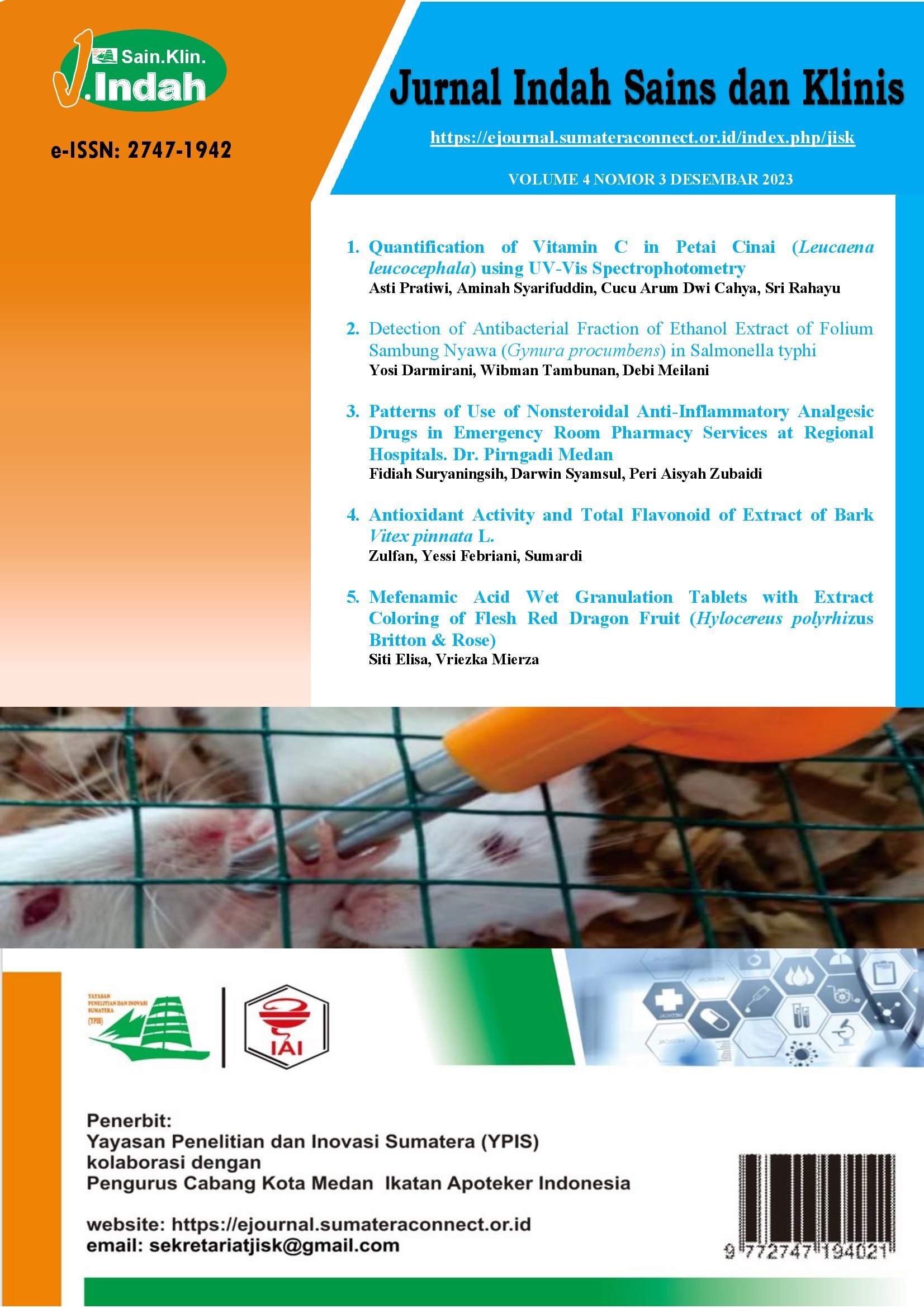Tablet Granulasi Basah Asam Mefenamat dengan Pewarna Ekstrak Daging Buah Naga Merah (Hylocereus polyrhizus Britton and Rose)
DOI:
https://doi.org/10.52622/jisk.v4i3.05Kata Kunci:
Colorants, wet granulation, tablet formulationAbstrak
Background: Natural dyes have been used for a long time, and are generally considered safer than synthetic dyes, including red anthocyanins, which are produced, among others, by red dragon fruit. Dyes can be used to provide identity to products, making product identification easier, and helping to minimize the possibility of confusion during the production process. The addition of colouring to the tablet also adds aesthetic value. On the market mefenamic acid tablets are white, they have not been found in other colours. Objective: The research was directed to determine whether red dragon fruit flesh extract can be used as a natural colouring in mefenamic acid tablet preparations using the wet granulation method. Method: Red dragon fruit flesh extract was prepared by maceration using 96% ethanol. Results: Tablet formulations were made from formulas 1 to 6 with red dragon fruit extract 9 each; 10; 14.5; 12.5; 16.5; and 18.5%. The best formula for red dragon fruit juice is formula 2, for red dragon fruit flesh extract the best formula is formula 3, 4, 5 and 6. Because it meets the requirements of the Indonesian Pharmacopoeia Edition VI. Conclusion: Red dragon fruit extract and juice can be moulded into tablets, meeting all quality requirements of the Indonesian Pharmacopoeia Edition VI.
Unduhan
Referensi
L. Lachman, H. A. Lieberman, and J. L. Kanig, Teori dan Praktek Farmasi Industri. Jakarta: UI Press, 1994.
M. Gunawan, Suprianto, Samran, C. Fatimah, D. Melani, and Sumardi, “Tablet Kompresi Langsung Ekstrak Etanol Daun Salam (Syzygium polyanthum),” J. Indah Sains dan Klin., vol. 2, no. 3, pp. 1–6, 2021, doi: 10.52622/jisk.v2i3.31.
H. Nurcahyo, Farmasetika: Dasar Terapan. Pasir Kidul: Zahira Media Publisher, 2022.
R. I. Kemenkes, Farmakope Indonesia, Edisi VI. Jakarta: Kementrian Kesehatan Republik Indonesia, 2020.
L. Simanjuntak, C. Sinaga, and F. Fatimah, “Ekstraksi Pigmen Antosianin dari Kulit Buah Naga Merah (Hylocereus polyrhizus),” 2014.
N. Nasrullah, H. Husain, and M. Syahrir, “Pengaruh Suhu dan Waktu Pemanasan terhadap Stabilitas Pigmen Antosianin Ekstrak Ssam Sitrat Kulit Buah Naga Merah (Hylocereus polyrizus) dan Aplikasi pada Bahan Pangan,” Chemica, vol. 21, no. 2, pp. 150–162, 2020.
M. M. D. Masyhura, M. I. Nusa, and D. Prasetya, “Aplikasi Ekstrak Kulit Buah Naga Merah (Hylocereus polyrhizus) pada Pembuatan Susu Kedelai (Hylocereus polyrhizus),” Agrintech J. Teknol. Pangan dan Has. Pertan., vol. 2, no. 1, 2018.
K. R. N. Amaliasari, S. H. Putri, and A. Bunyamin, “Formulasi Pemerah Pipi (Blush on) dari Ekstrak Kulit Buah Naga Merah (Hylocereus polyrhizus),” J. Teknol. Pertan. Andalas, vol. 25, no. 2, pp. 183–191, 2021.
A. D. P. Ramadhani, K. Nuzulina, A. Yulianto, and M. P. Aji, “Pigmen Antosianin Kulit Buah Naga (Hylocereus polyrhizus) sebagai Tinta Organik,” J. Fis., vol. 7, no. 2, pp. 50–54, 2017.
R. S. Harjanti, “Optimasi Pengambilan Antosianin dari Kulit Buah Naga Merah (Hylocereus polyrhizus) sebagai Pewarna Alami pada Makanan,” Chemica, vol. 3, no. 2, pp. 39–45, 2016.
G. A. A. Almajid, R. Rusli, and M. Priastomo, “Pengaruh Pelarut, Suhu, dan pH Terhadap Pigmen Antosianin dari Ekstrak Kulit Buah Naga Merah (Hylocereus Polyrhizus): Effect of Solvent, Temperature, and pH on Anthocyanin Pigments from Red Dragon Fruit Peel Extract (Hylocereus Polyrhizus),” in Proceeding of Mulawarman Pharmaceuticals Conferences, 2021, pp. 179–185.
Q. Ayun and R. Endara, “Optimasi Ekstrak Kulit Buah Naga Merah (Hylocereus Costaricensis) untuk Mendapatkan Kadar Antosianin Maksimal,” Pros. Konf. Nas. Mat. dan IPA Univ. PGRI Banyuwangi, vol. 2, no. 1, pp. 175–181, 2022.
W. Setyani and D. C. A. Putri, Resep dan Peracikan Obat. Yogyakarta: Sanata Dharma University Press, 2020.
Departemen Kesehatan Republik Indonesia, Parameter Standar Umum Ekstrak Tumbuhan Obat. Jakarta: Kementrian Kesehatan Republik Indonesia, 2000.
J. Elviangraini, “Preformulasi dan Evaluasi Sediaan Tablet dari Ekstrak Etanol Daun Kopasanda (Chromolaena odorata L.) dengan Variasi Gelatin sebagai Bahan Pengikat,” Institut Helvetia Medan, 2019.
Unduhan
Diterbitkan
Terbitan
Bagian
Lisensi
Hak Cipta (c) 2024 Jurnal Indah Sains dan Klinis

Artikel ini berlisensiCreative Commons Attribution-NonCommercial-ShareAlike 4.0 International License.










